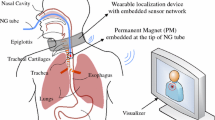Abstract
Objective
A novel endotracheal intubation accurate positioning confirmation system based on image classification algorithm is introduced and evaluated using a mannequin model.
Methods
The system comprises a miniature complementary metal oxide silicon sensor (CMOS) attached to the tip of a semi rigid stylet and connected to a digital signal processor (DSP) with an integrated video acquisition component. Video signals acquired and processed by an algorithm implemented on the processor. During mannequin intubations, video signals were continuously recorded. A total of 10 videos were recorded. From each video, 7 images of esophageal intubation and 8 images of endotracheal intubation (in which the carina could be clearly seen) were extracted, yielding a total of 150 images taken from arbitrary positions and angles which were processed by the confirmation algorithm.
Results
The performance of the confirmation algorithm was evaluated using a leave-one-out method: in each iteration, 149 images were used to train the system and estimate the models, and the remaining image was used to test the system. This process was repeated 150 times such that each image participated once in testing. The system correctly identified 80 out of 80 endotracheal intubations and 70 out of 70 esophageal intubations.
Conclusions
This fully automatic image recognition system was used successfully to discriminate airway carina and non-carina endotracheal tube positioning. The system had a 100% success rate using a mannequin model and therefore further investigation including live tissue model and human research should follow.
Similar content being viewed by others
References
Nolan JP, Deakin CD, Soar J. European resuscitation council guidelines for resuscitation 2005. Section 4. Adult advanced life support. Resuscitation. 2005;67:S39–S86.
Yap SJ, Morris RW, Pybus DA. Alterations in endotracheal tube position during general anesthesia. Anaesth Crit Care. 1994;22:586–588.
Tovar E, Abshier S, Borsari A, Patel R. Mainstem bronchial intubation: an unrecognized source of hypotension during coronary artery bypass surgery. J Cardiothorac Vasc Anesth. 1997;11(5):615–618.
Timmermann A, Eich C, Russo SG. Prehospital arirway management: a prospective evaluation of anaesthesia trained emergency physicians. Resuscitation. 2006;70:179–185.
Timmermann A, Russo SG, Eich C, Roessler M, Braun U, Rosenblatt WH, Quintel M. The out-of-hospital esophageal and endobronchial intubations performed by emergency physicians. Crit Care Trauma. 2007;104(3):619–623.
Schwart DE, Matthay MA, Cohen NH. Death and other complications of emergency airway management in critically ill adults. A prospective investigation of 297 tracheal intubations. Anesthesiology. 1995;82:367–376.
Vergese ST, Hannallah RS, Slack MC, Cross RR, Patel KM. Auscultation of bilateral breath sounds does not rule out endobronchial intubation in children. Anesht Analg. 2004;99:56–58.
Caplan RA, Posner KL, Ward RJ, Cheney FW. Adverse respiratory events in anesthesia: a closed claims analysis. Anesthesiology. 1990;72:828–833.
Klepper ID, Webb RK, Walt JVD, Ludbrooks GL, Cockings J. The stethoscope: application and limitation- an analysis of 2000 incident reports. Anaesth Intens Care. 1993;21(5):575–578.
Wodicka GR, DeFrain PD, Kraman SS. Bilateral asymmetry of respiratory acoustic transmission. Med Biol Eng Comp. 1994;32(5):489–494.
Gravenstein JS, Jaffe MB, Paulus DA, editors. Capnography clinical aspects. Cambridge: Cambridge University Press; 2004.
Wang HE, Lave JR, Sirion CA, Yealy M. Paramedic intubation errors: isolated events or symptoms of larger problems? Health Aff. 2006;25(2):501–509.
Bjoraker DG. Airway management in the operating room. In: Capnography clinical aspects, chapter. Cambrdige: Cambrdige University Press; 2004. p. 39–44.
Bhende SM, Thompson AE. Evaluation of an end-tidal CO2 detector during pediatric cardiopulmonary resuscitation. Pediat. 1995;95(3):395–399.
Li J. Capnography alone is imperfect for endotracheal tube placement confirmation during emergency intubation. J Emerg Med. 2001;20(3):223–229.
Webb RK, Walt JHVD, Runciman WB, Williamson JA, Cockings J, Russell WJ, Helps S. Which monitor? an analysis of 2000 incident reports. Anaesth Intens Care. 1993;21(5):529–542.
O’connor CJ, Mansy H, Balk RA, Tuman KJ, Sandler RH. Identification of endotracheal tube malpositions using computerized analysis of breath sounds via electronic stethoscopes. Anesth Analg. 2005;101(3):735–739.
Tejman-Yarden S, Lederman D, Weksler N, Gurman G. Acoustic monitoring of double lumen ventilated lungs for the detection of selective unilateral lung ventilation. Anesth Analg. 2006;103:1489–1493.
Lederman D. An energy ratio test for one lung intubation detection, in Proceedings of the 18th Biennial International EURASIP Conference, Brno, Czech Republic. 2006.
Tejman-Yarden S, Zlotnik A, Weizman L, Tabrikian J, Cohen A, Weksler N, Gurman GM. Acoustic monitoring of lung sounds for the detection of one-lung intubation. Anesth Analg. 2007;105(2):397–404.
Weizman L, Tabrikian J, Cohen A. Detection of one-lung intubation incidents. Ann Biomed Eng. 2008;36(11):1844–1855.
Weiss M. Video-intuboscopy: a new aid to routine and difficult tracheal intubation. Br J Anaesth. 1998;80:525–527.
Shikani AH. New “seeing” stylet scope and method for the management of the difficult airway. Otolaryngol Head Neck Surg. 1999;120(1):113–116.
Haralick RM. Statistical and structural approaches to texture. Proc IEEE. 1979;67:786–804.
Haralick RM, Shapiro LG. Computer and robot vision. Boston: Addison-Wesley Longman Publishing Co., Inc; 1992.
Haralick RM, Shanmugan K, Dinstein I. Textural features for image classification. IEEE Trans Syst Man Cybernetics. 1973;SMC-3:610–621.
Jensen JR. Introductory image processing: a remote sensing perspective. 3rd ed. Upper Saddle River: Pearson Prentice Hall; 2005.
Gotliev C, Kreyszig HE. Texture descriptors based on co-occurrence matrices. Comput Vision Graph Image Process. 1990;51:70–86.
Duda RO, Hart PE, Stork DG. Pattern classification. 2nd ed. New Jork: A Wiley-Interscience Publication; 2000.
Rose RC, Reynolds DA. Text-independent speaker identification using automatic acoustic segmentation. In IEEE Int Conf Acous Speech and Signal Proc 1990; 293–296.
Reynolds DA. A Gaussian mixture modeling approach to text-independent speaker identification, Ph.D. thesis, Georgia Institute of Technology, Atlanta. 1992.
Dempster AP, Laird NM, Rubin DB. Maximum likelihood from incomplete data via the EM algorithm. J Roy Stat Soc B. 1977;39:1–38.
Author information
Authors and Affiliations
Corresponding author
Additional information
Lederman D, Shamir MY. Novel automatic endotracheal position confirmation system: Mannequin model algorithm evaluation.
Rights and permissions
About this article
Cite this article
Lederman, D., Shamir, M.Y. Novel automatic endotracheal position confirmation system: Mannequin model algorithm evaluation. J Clin Monit Comput 24, 335–340 (2010). https://doi.org/10.1007/s10877-010-9253-1
Received:
Accepted:
Published:
Issue Date:
DOI: https://doi.org/10.1007/s10877-010-9253-1




